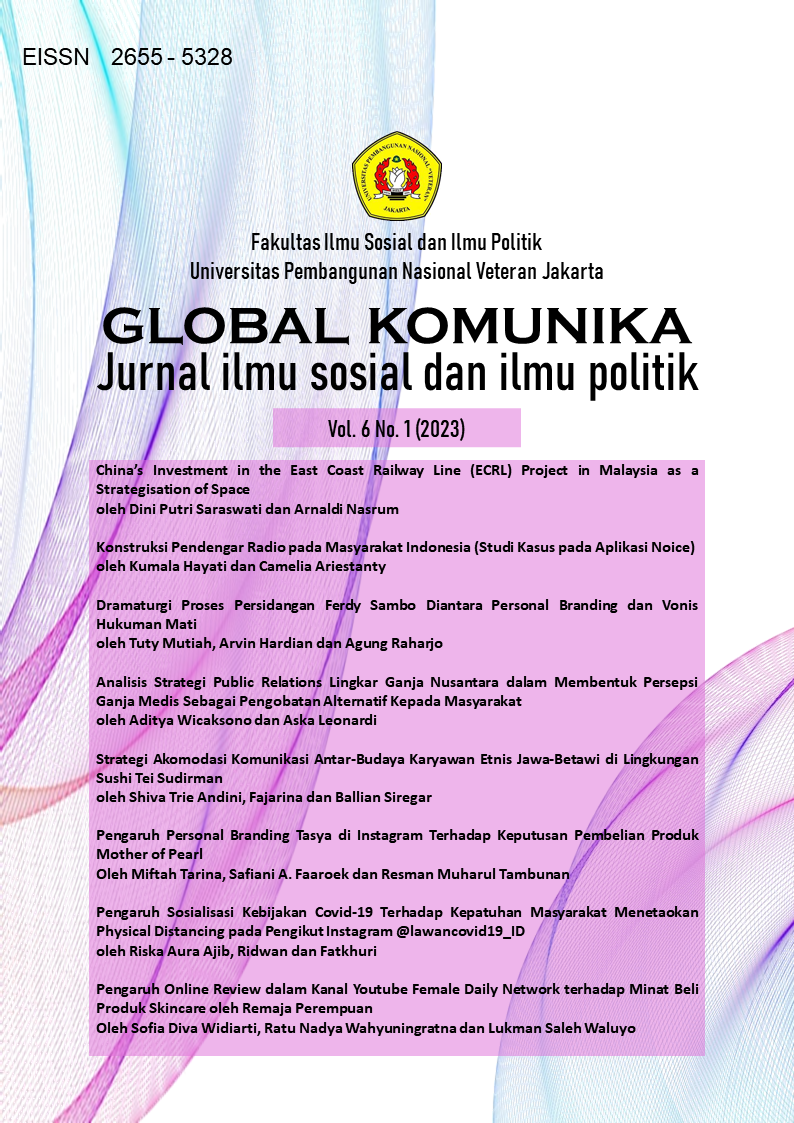China’s Investment in the East Coast Railway Line (ECRL) Project in Malaysia as a Strategisation of Space
DOI:
https://doi.org/10.33822/gk.v6i1.5762Keywords:
China, Malaysia, BRI Project, ECRL Project, Foreign PolicyAbstract
The rise of China’s power has led the country to fulfil more energy supply to sustain its industrial development. However, the Straits of Malacca challenges disturbed China’s interest to transport oil from the Middle East. Hence, China chooses the BRI project to maintain the problem. This paper will try to examine China’s strategy of constructing an ECRL project in Malaysia as one of the BRI projects to be an alternative to fulfil its energy supply. This qualitative research will employ the concept of power and connectivity. The use of the ECRL Project to Strategise Chinese Interest in energy supply will also be explained to answer the research questions.
References
Abidin, I. S. Z. (2017, September 23). ECRL, connecting East and West. New Strait Times [online] Retrieved December 13, 2017, from https://www.nst.com.my/opinion/columnists/2017/09/282972/ecrl-connecting-east-and-west.
Anonymous. (2017, August 11). ECRL is China’s way to get Malaysia’s support, says the report. The Malaysian Insight [online] Retrieved December 12, 2017, from https://www.themalaysianinsight.com/s/10443/.
Bijian, Z. (2004). “China’s peaceful rise and opportunities for the Asia-Pacific Region.” Speech on the Roundtable Meeting between the Bo’ao Forum for Asia and the China Reform Forum. Bo’ao, Hainan. 18 April 2004.
Blanchard, J. F. & Flint, C. (2017). The geopolitics of China’s maritime silk road initiative. Geopolitics, 22(2), 223 – 245.
Chia, A. & Leng, L. Y. (1987). The strategic strait with special reference to the Malacca Straits. Singapore Journal of Tropical Geography, 8(2), 97 – 113.
Freedman, L. Strategy: A history. Oxford: Oxford University Press, 2013.
Goh, E. (2011, April 26). Limits of Chinese power in Southeast Asia. Yale Global Online [online] Retrieved December 12, 2017, from https://yaleglobal.yale.edu/content/limits-chinese-power-southeast-asia.
Grey, E. (2017, October 1). China turns Malaysia’s East Coast Rail Link into reality. Railway Technology [online] Retrieved December 12, 2017, from https://www.railway-technology.com/features/featurechina-turns-malaysias-east-coast-rail-link-into-reality-5938409/.
Hays, P. (2017, September 30). The impact of Chinese investment in Malaysia. Global Risk Insights [online] Retrieved November 20, 2017, from http://globalriskinsights.com/2017/09/impact-chinese-investments-malaysia/.
Kristof, N. D. (1993). The rise of China. Foreign Affairs, 72(5), 59 – 74.
Lee, C. (2016). Deepening of Malaysia’s economic ties to China: What are the implications? Perspective, 69, 1 – 12.
Lee, L. (2017, August 9). Hard-pedalling soft power, China helps launch $13 bln Belt and Road rail project in Malaysia. Reuters [online] Retrieved December 12, 2017, from https://af.reuters.com/article/commoditiesNews/idAFL4N1KU28Z.
Liu, W. & Dunford, M. (2016). Inclusive globalization: Unpacking China’s belt and road initiative. Area Development and Policy, 1(3), 323 – 340.
Lobo-Guerrero, L. (2012). Connectivity as the strategization of space – the case of Port of Hamburg. Distinktion: Journal of Social Theory, 13(3), 310 – 321.
Loh, F. (2017, September 7). BRI and spike in Chinese investments in Malaysia: What are the implications for Malaysia’s politics and sovereignty? Aliran [online] Retrieved November 20, 2017, from https://aliran.com/aliran-csi/aliran-csi-2017/bri-spike-chinese-investments-malaysia-implications-malaysias-politics-sovereignty/.
Matamala, E. L. (2012). Port-rail integration: Challenges and opportunities for Latin America. United Nations Economic Commission for Latin America and the Caribbean.
Miu, R., Tjen-San, C., & Leung, C. (2017). One belt one road: Moving faster than expected. DBS Asian Insights.
Nye, J. S. (2009). Get smart: Combining hard and soft power. Foreign Affairs, 88(4), 160 – 163.
Patrick, A. (2017). Melaka Gateway Port: An analysis. National Maritime Foundation.
Qu, X. & Meng, Q. (2011). The economic importance of the Straits of Malacca and Singapore: An extreme-scenario analysis. Transportation Research Part E, 48, 258 – 265.
Rosely, S. (2016). Construction: ECRL rolls into the rail theme. Equity Research.
Sarma, J. & Reinert, M. (2013). The Malacca dilemma. India Institute of Technology Madras China Studies Centre, 64. Retrieved December 9, 2017, from https://csc.iitm.ac.in/articles/malacca-dilemma.
Shenkar, O. (2006). China’s economic rise and the new geopolitics. International Journal, 61(2), 313 – 319.
Storey, I. (2006). China’s “Malacca dilemma.” China Brief, 6(8). Retrieved November 20, 2017, from https://jamestown.org/program/chinas-malacca-dilemma/.
Stuart-Fox, M. (2004). Southeast Asia and China: The role of history and culture in shaping future relations. Contemporary Southeast Asia, 26(1), 116 – 139.
Tessman, B. and Wolfe, W. (2011). Great powers and strategic hedging: The case of Chinese energy security strategy. International Studies Review, 13, 214 – 240.
United States Energy Information Administration. (2015). China. United States Energy Information Administration.
van der Putten, F. & Meijnders, M. (2015). China, Europe, and the maritime silk road. The Hague, The Netherlands: Clingendael Institute.
Wilson III, E. J. (2008). Hard power, soft power, smart power. The Annals of the American Academy of Political and Social Science, 616(1), 110 – 124.
Zhang, Z. X. (2011). China’s energy security, the Malacca dilemma, and responses. Energy Policy, 39(12), 7612 – 7615.
Zhao, S. (2008). China’s global search for energy security: Cooperation and competition in Asia- Pacific. Journal of Contemporary China, 17(55), 207 – 227.
Zhong, Y. (2016). The importance of the Malacca Dilemma in the Belt and Road Initiative. Journal of Policy Science, 10, 85 – 109.
Downloads
Published
Issue
Section
License

This work is licensed under a Creative Commons Attribution 4.0 International License.
Kebijakan yang diajukan untuk jurnal yang menawarkan akses terbuka
Syarat yang harus dipenuhi oleh Penulis sebagai berikut:
- Penulis menyimpan hak cipta dan memberikan jurnal hak penerbitan pertama naskah secara simultan dengan lisensi di bawah Creative Commons Attribution License yang mengizinkan orang lain untuk berbagi pekerjaan dengan sebuah pernyataan kepenulisan pekerjaan dan penerbitan awal di jurnal ini.
- Penulis bisa memasukkan ke dalam penyusunan kontraktual tambahan terpisah untuk distribusi non ekslusif versi kaya terbitan jurnal (contoh: mempostingnya ke repositori institusional atau menerbitkannya dalam sebuah buku), dengan pengakuan penerbitan awalnya di jurnal ini.
- Penulis diizinkan dan didorong untuk mem-posting karya mereka online (contoh: di repositori institusional atau di website mereka) sebelum dan selama proses penyerahan, karena dapat mengarahkan ke pertukaran produktif, seperti halnya sitiran yang lebih awal dan lebih hebat dari karya yang diterbitkan. (Lihat Efek Akses Terbuka).







